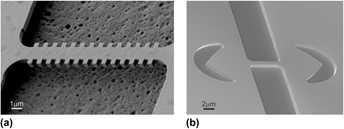Article contents
Top-down method to introduce ultra-high elastic strain
Published online by Cambridge University Press: 14 February 2017
Abstract

Elastic strain is an effective and thus widely used parameter to control and modify the electrical, optical, and magnetic properties of crystalline solid-state materials. It has a large impact on device performance and enables adjusting the materials functionality. Here, we promote a micromechanical strain enhancement technology to achieve ultra-high strain in semiconductors. The here presented suspended membranes enable the accurate control of the strain on a wafer-scale by standard top-down fabrication methods making it attractive for both device applications and also, thanks to the simplicity of the method, for fundamental research. This review aims at discussing the process of strain enhancement and its usage as an investigation platform for strain-related physical properties. Furthermore, we present design rules and a detailed analysis of fracture effects limiting the strain enhancement.
- Type
- Invited Paper
- Information
- Copyright
- Copyright © Materials Research Society 2017
Footnotes
References
REFERENCES
- 9
- Cited by





